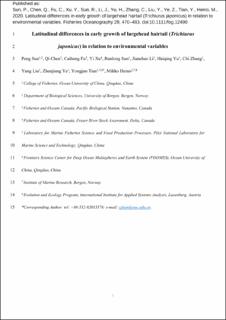| dc.description.abstract | Largehead hairtail (Trichiurus japonicus) in the China Seas shows an increasing catch trend, despite continued overexploitation, which could be attributed to improved recruitment as a result of strengthened early growth. To understand the early growth variability of largehead hairtail, we examined the linkages between early growth, as revealed by otolith microstructure, and the associated environmental variables over both spatial and temporal scales. Young‐of‐the‐Year largehead hairtail were collected from three regions in the Bohai, Yellow and East China Seas between 29° and 39° N. Daily increment widths of sagittal otoliths were measured and used as a proxy for somatic growth. We found two spawning cohorts, Spring‐ and Summer‐spawned cohorts, that showed latitudinal differences in both mean growth and growth pattern. The transition time from larval to juvenile stage was identified at around 40 days. Daily increment widths of two cohorts showed similar growth pattern in the first 40 days, while location had a marked effect on daily growth over 41–110 days. This suggests physiologically constrained growth pattern in larval stage, but more plastic growth subject to habitat‐specific influences in juvenile stage. The gradient forest analysis identified sea bottom temperature, vertical temperature gradient, and sea surface salinity, as the most important variables in determining early growth. Latitudinal differences in early growth pattern and their response to environmental variables suggest adaptive plasticity of early growth, which has notable implication for the management and sustainable utilization of this important but heavily exploited resource in the China Seas. | en_US |
